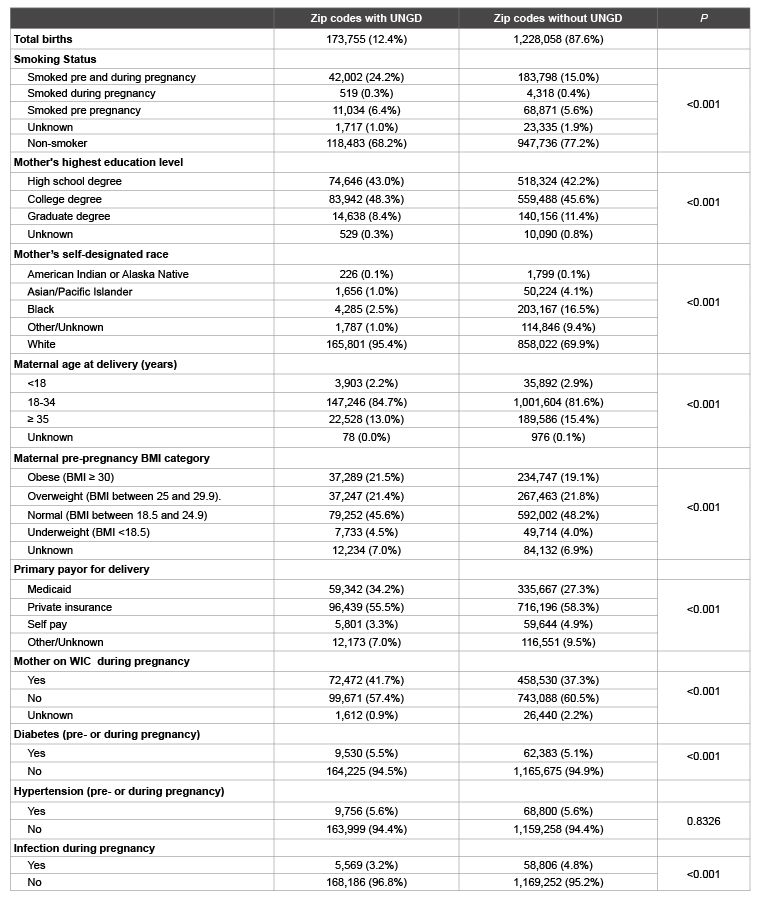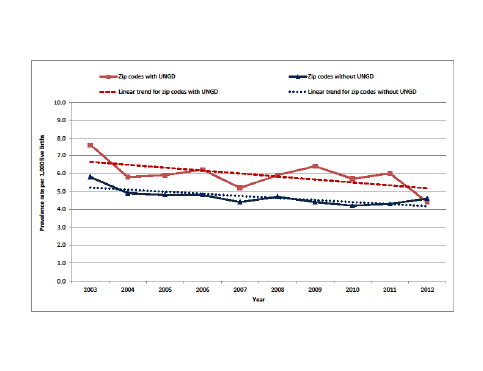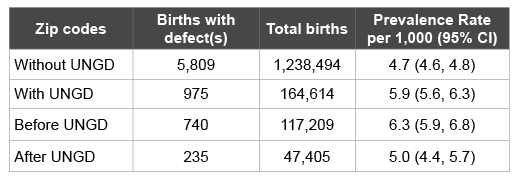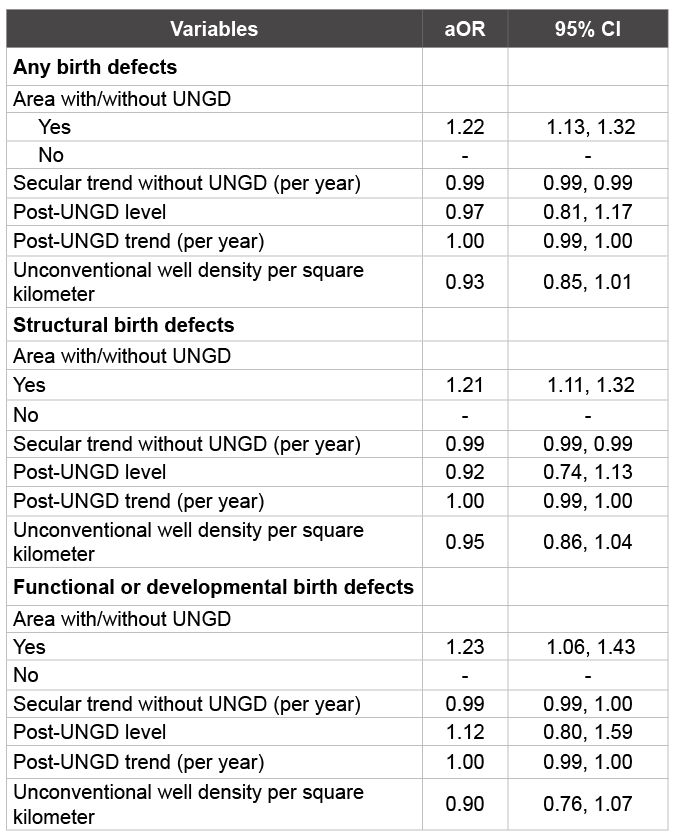
Figure 1: Distribution of Unconventional Marcellus Shale Natural Gas Wells in Pennsylvania

Zhen-qiang Ma*1 Katie C. Sneeringer2 Longjian Liu3 Lewis H. Kuller4
1Bureau of Epidemiology, Pennsylvania Department of Health, Harrisburg, PA, USA*Corresponding author: Zhen-qiang Ma, Bureau of Epidemiology, Pennsylvania Department of Health, Harrisburg, PA, USA, Tel: 717 547 3224; E-mail: zma@pa.gov
Few studies have evaluated the association of unconventional natural gas development (UNGD) on birth defects and most of them neglect birth defects secular trend prior to UNGD and did not fully take into account maternal characteristics. We used 2003-2012 Pennsylvania birth registry data to assess the association between UNGD and birth defects using segmented regression analysis of interrupted time series method controlling for maternal characteristics and pre-drilling secular trend. Among areas with UNGD, birth defects prevalence rate was 6.3/1,000 live births before UNGD and 5.0/1,000 live births after UNGD, a 20.6% drop with P<0.01, while birth defects prevalence rate in zip code areas without UNGD was 4.7/1,000 live births. After controlling for maternal characteristics and secular trend, the adjusted odds ratio (aOR) for annual postUNGD birth defects trend did not change (aOR=1.00, P=0.29) and post-UNGD birth defects level decreased but was not statistically significant (aOR =0.97, P=0.12). The aOR for unconventional well number per square kilometer was 0.93, P=0.10. We conclude UNGD was not associated with birth defects prevalence rate trend and level changes. Further studies are needed to address why birth defects prevalence rate in UNGD areas were consistently 22% higher than in non-UNGD areas.
Hydraulic fracturing; Unconventional wells; Birth defects; Time series
UNGD: Unconventional Natural Gas development; aOR: Adjusted Odds Ratio; CI: Confidence Interval; CDC: Center for Disease Control and Prevention; BMI: Body Mass Index; WIC: Women, Infants, and Children
Natural gas plays an important role in the United States’ (U.S.) energy demands, providing more than 22% of the country’s energy [1]. One such source of gas is shale gas, which is gas formed and trapped within shale rock formations. In 2009, shale gas provided 20% of the U.S. gas supply, and it is estimated that by 2035 shale gas may provide upwards of 70% of the total gas supply [2]. The largest shale gas source in the U.S. is the Marcellus Shale. The Marcellus Shale spans six states across the northeastern U.S., including approximately two-thirds of Pennsylvania [3].
In order to extract the natural gas held within the Marcellus Shale formation, both horizontal and vertical drilling in combination with hydraulic fracturing is required. Hydraulic fracturing involves the use of large volumes of water-based fluids, and as a result, large volumes of waste water are produced. The fluid utilized throughout the fracturing process involves a large number of chemicals and additives. According to the U.S. Committee on Energy and Commerce, these chemicals ranged from common and harmless to extremely toxic, such as benzene and lead [4,5]. Twenty nine of these chemicals were identified as either a known or possible carcinogen, regulated under the Safe Water Drinking Act for their risks to human health, or listed as hazardous air pollutants under the Clean Air Act [4]. Many of the chemicals used in the process had the potential to induce long-term health effects [5,6]. In Pennsylvania, 85 chemicals used by hydraulic fracturing companies have been identified [7]. There are a number of possible exposure routes to these chemicals, predominately via water and air pollution [8].
Despite an increase in unconventional natural gas development (UNGD) across the country, the exposures to the chemicals utilized throughout the process and the potential health impacts remain poorly understood. Many chemicals utilized in drilling operations have yet to be thoroughly analyzed, due to a lack of Chemical Abstract Service numbers or other necessary information [8]. About 37% of the chemicals that were able to be identified by Chemical Abstract Service numbers used in UNGD had the ability to affect the endocrine system [6]. These endocrine disrupting chemicals are of concern, as exposure during key periods of development can impact normal development and result in a number of deleterious health effects. Fetal development is an especially sensitive time in which exposure to endocrine disruptors may result in permanent physiological changes that would not be seen in adults exposed to similar levels of chemicals [9]. Most birth defects occur during the first three months of pregnancy, the time of organogenesis [10]. The Center for Disease Control and Prevention (CDC) estimates that 3% of babies born in the U.S. each year are born with a birth defect and birth defects are the leading cause of infant mortality in the United States [10].
Although the causes of birth defects are multifactorial, in utero exposures to endocrine disruptors are associated with a number of negative birth outcomes [11]. Exposure to the chemicals used in UNGD during prenatal and early postnatal development could potentially cause permanent damage to the growing embryo, fetus, and neonate. Therefore, there is an emerging need to increase our knowledge of the potential health consequences of UNGD through thorough health research investigations [12,13].
Kassotis and colleagues found elevated compound estrogenic, antiestrogenic, or antiandrogenic activities in water samples collected from locations in a drilling-dense region of Colorado compared to samples from reference sites with limited drilling operations nearby [14]. This suggests that UNGD might result in elevated levels of endocrine disrupting chemicals in surface and groundwater [14]. Further, a study analyzed the association between maternal residential proximity to natural gas development locations and subsequent birth outcomes, and observed that an increased prevalence rate of congenital heart defects and neural tube defects were associated with the density and proximity of natural gas wells to maternal residence [15].
For the limited number of health outcome studies, the majority analyzed the association of adverse health outcomes in relation to distance from the drilling sites. They generally lack methodological rigor due to limitations of the data collection and study design [16-19]. While those health outcomes evaluated may be higher in areas close to the drilling sites, these analyses do not address causal effects. Additionally, none of these studies take into account the secular trend and level before drilling in their studies. This lack of pre-drilling trend and level analysis may lead to the conclusions that differences in health outcomes are due to the effect of drilling. In order to address this issue, we propose an interrupted time series regression method to control for baseline level and trend when evaluating the potential change in birth defects prevalence rate due to UNGD. We aim to investigate and evaluate the prevalence rate of birth defects and its potential association with UNDG, using data from Pennsylvania vital birth registry records. We evaluated post UNDG birth defects rates trend and level changes while controlling for pre-drilling birth defects rates secular trend and level and maternal characteristics.
Pennsylvania unconventional natural gas well data were ascertained from Application and production reports available through the Pennsylvania Department of Environmental Protection. Unconventional drilling wells’ zip codes were determined by wells’ longitude and latitude using ArcGIS 10.1 (ESRI, Redlands, California) geo coding process (Figure 1). Spud date was defined by Pennsylvania Department of Environmental Protections the date that the setting of conductor pipe commences or the setting of the initial casing string commences [20]. Within each zip code, the earliest spud date was used as a proxy for potential exposure date. We also created an unconventional well density variable using total number of unconventional wells/square kilometers for each zip code.
The revised 2003 to 2012 Pennsylvania birth certificate data with a total of 1,424,170 live births to Pennsylvania resident mothers were used for this analysis. Of these births, 22,357 (1.6%) were excluded due to the missing information on zip code or gestational age; 1,401,813 births were included in this study. Structural birth defects was defined as having any one of the following congenital anomalies on birth certificate: anencephaly, meningomyelocele/spina bifida, cyanotic congenital heart disease, congenital diaphragmatic hernia, omphalocele, gastroschisis, limb reduction defect, cleft lip with/without cleft palate, cleft palate alone, or hypospadias. Functional or developmental birth defect was defined as having Down syndrome, suspected chromosomal disorder on birth certificate. Any birth defect was defined as having either structure or functional birth defects. Table 1 show maternal characteristics used in this analysis. Estimated conception date was created using birth date minus the estimated gestational age to account for the earliest possible exposure date. Mother’s residence at delivery was used to assign each birth to a zip code.
Birth records were linked to well data by zip codes. For each birth record, we created four more variables:
Secular trend without UNGD: A continuous time variable from Jan 2003 to Dec 2012 with Jan 2003 as 1 and increased by 1 for every month thereafter. So a birth record with birth date in Jan 2003 with have a value of 1, a birth record with birth date in Feb 2003 will have a value of 2, and a birth record with birth date in March 2003 will have a value of 3 and so forth. This variable is used to control for the secular trend without UNGD.
Post-UNGD level: A record with an estimated conception date before the earliest spud date in the same zip code, the record will be assigned a value of 0, a record with the estimated conception date the same or after the earliest spud date will have a value of 1. This value is used to estimate the immediate impact on birth defects prevalence rate level change.
Post-UNGD trend: A birth record with an estimated conception date the same or before the earliest spud date for the same zip code will have a value of 0 and a birth record with the estimated conception date 1 month after the earliest spud will have a value of 1. A birth record with the estimated conception date 2 month after the earliest spud will have a value of 2 and so forth. This variable is used to estimate the post-UNGD trend.
Area with/without UNGD: zip code with a spud date between 2003 and 2012 will be assigned with a value of 1, zip codes without a spud date between 2003 and 2012 will be assigned with a value of 0. This variable is used to estimate the birth defects prevalence rate difference between areas with and without UNGD.
We first calculated and compared the birth defects rate among zip codes without UNGD, before and after UNGD in zip codes with UNGD. Then we used logistic regression to compare birth defects prevalence rate trend between zip codes with and without UNGD. An interaction term with year and UNGD (yes/no) in the model was assessed.
A segmented regression analysis of interrupted time-series method [21] was used to estimate the changes in the level and trend in the birth defects prevalence rate while controlling for maternal characteristics. The binary outcome of birth defects (Yes/No) was the dependent variable and secular trend without UNGD, post-UNGD level, post-UNGD trend, area with/ without UNGD, unconventional well density and maternal characteristics were the independent variables in the final model. The interaction between the secular trend without UNGD and the post-UNGD trend was assessed to determine the trend change before and after UNGD. Hosmer and Lemeshow test was used for logistic model fit diagnosis. SAS software version 9.3 (SAS Institute Inc., Cary, North Carolina) was used for all statistical analyses. A two-sided P-value of less than 0.05 was considered significant.
A summary of maternal characteristics between areas with and without UNGD is displayed in table 1. The differences were observed in all maternal characteristics except pre and during pregnancy hypertension rate. The crude birth defects prevalence rate in zip code areas without UNGD was 4.7 per 1,000 live births from 2003-2012; among zip code areas with UNGD, the birth defects prevalence rate was 20.6% lower after UNGD than before UNGD (5.0 vs. 6.3 per 1,000 live births, P<0.01) (Table 2). Pre-UNGD crude birth defects prevalence rate in areas with UNGD was higher than the birth defects prevalence rate in the areas without UNGD (6.3 vs. 4.7 per 1,000 live births, P<0.01) and post-UNGD birth defects prevalence rate was slightly higher but not statistically significant than the birth defects prevalence rate in areas without UNGD (P=0.40).The odds ratio for unconventional drilling well density per square kilometer on birth defects was 0.93 with P=0.10.

Figure 1: Distribution of Unconventional Marcellus Shale Natural Gas Wells in Pennsylvania
When we examine the birth defects prevalence rate trend from 2003 to 2012, we see birth defects prevalence rates in both areas with and without UNGD had a decreasing yearly trend from 2003 to 2012 (Table 3 and Figure 2). The yearly birth defects prevalence rates were on average 31.6% higher in areas with UNGD than the birth defects prevalence rates in areas without UNGD. The yearly birth defects prevalence rates decreasing trends between areas with and without UNGD were parallel with an average of 0.16 per 1,000 live births reduction per year from 2003 to 2012. The interaction term between year and areas not statistically significant, P=0.79, indicating the birth defects prevalence rate trend in areas with UNGD was parallel to the birth defects prevalence rate trend in areas with UNGD.
With multivariate regression model using any birth defects as a dependent variable and maternal characteristics, unconventional well density and yearly trend and level and drilling as independent variables, we see the following for any birth defects: the zip codes with UNGD had a 22% higher birth defects prevalence rate compared to those zip codes without UNGD (aOR=1.22, 95%CI: 1.13, 1.32) (Table 4). There was a slight yearly decreasing trend in the risk of birth defects prevalence rate from 2003 to 2012 for both areas with and without UNGD (aOR=0.99, 95% CI: 0.99, 0.99). The interaction term between secular trend without UNGD and post-UNGD trend was not statistically significant (p=0.56) meaning the birth defects prevalence rate trend did not change after UNGD. The post-UNGD birth defects prevalence level was not statically significant (aOR=0.97, 95% CI: 0.81, 1.17) indicating no immediate effect of UNGD on birth defects prevalence rate. We run the model separately for structure birth defects and functional or developmental birth defects and the results were similar (Table 4).
Our analysis shows birth defects prevalence rate in areas with UNGD decreased 20.6% after UNGD (6.3 vs. 5.0 per 1,000 live births, P<0.01). Yearly birth defects prevalence rates in both areas with and without UNDG had decreasing trend and were parallel to each other. After adjusting for maternal characteristics, birth defects prevalence rate trend and level did not change post UNGD. Birth defects were not associated with unconventional well density in zip codes with UNGD. All of these results suggest UNGD was not associated with birth defects.
Unconventional drilling technology has been in practice for over 40 years, but relevant health outcome studies are sparse. Recent review articles and Inter-Environmental Health Sciences Core Center Working Group on Unconventional Natural Gas Drilling Operations recommended epidemiological studies for health outcomes evaluations [12,13,22,23]. Studies have been focused on the differences between health outcomes in areas close to the drilling sites and in areas distant to the drilling sites [15,18].One study found some of the birth defects were associated with inverse distance to the drilling sites [15]. Our study was consistent with that conclusion and indicated a 22% higher birth defects rate in areas with UNGD comparing to areas without UNGD after controlling for unconventional well density and other maternal characteristics. Studies using the distance as proxies neglect the secular birth defects trend prior to drilling and also did not fully take into account maternal characteristics effects on birth defects. In the current study, birth defects prevalence rates in both areas with and without UNGD had decreasing trends from 2003 to 2012. Both the decreasing trend lines in areas with and without UNGD were parallel to each other. But areas with UNGD had a 22% higher birth defects rate than the areas without UNGD. UNGD were not significantly associated with either the birth defects trend or the birth defects level change while controlling for maternal characteristics. Also, unconventional well density was not associated with birth defects prevalence rate. These are indications that the higher birth defects rates in areas with UNGD were likely to be caused by factors other than drilling. For example, areas with drilling activities are usually rural, with farm land that could be heavily exposed to herbicides, pesticides, farm waste and others environmental factors that could cause the observed higher incident birth defects rate [24-26]. Other maternal behavior difference like drinking behaviors between women who live close to the drilling sites and those who live distances from the drilling sites may also play a vital role in the observed difference [27]. Pre-natal care and health insurance coverage may also play a role in early findings of birth defects and prompt mother take early medical termination of the pregnancy. Our study indicates the higher incident of birth defects is most likely not caused by drilling exposure but by some other characteristics not included in this analysis. The post drilling birth defects prevalence rate was 21% lower than the birth defects prevalence rate prior to the drilling in areas with UNGD, and therefore, the analysis does not support the finding that drilling increased the birth defects prevalence rate.

Table 1: Descriptive Summary of Maternal Characteristics between Zip Codes with and without UNGD, 2003-2012 Pennsylvania Birth Certificate.
UNGD: Unconventional Natural Gas Development; BMI: Body Mass Index; WIC: Women, Infants, and Children

Figure 2: Birth Defects Prevalence Rate Trend between Zip Codes with and without UNGD at Any Time from 2003-2012 Pennsylvania Birth Certificates

Table 2: Birth defect Prevalence Rate Comparison among Zip Codes
without Drilling, Before and After Drilling in Zip Codes with UNGD, 2003-
2012 Pennsylvania Birth Certificate.
UNGD: Unconventional Natural Gas Development; CI: Confidence Interval

Table 3: Birth Defect Prevalence Rate per 1,000 Live Births Trend Between
Zip Codes With and Without UNGD, 2003-2012 Pennsylvania Birth
Certificate
UNGD: Unconventional Natural Gas Development

Table 4: Multivariate Model of Association between Birth Defect and UNGD,
Unconventional Well Density Controlling for Maternal Characteristics
UNGD: Unconventional Natural Gas Development; AOR: Adjusted Odds
Ratio; CI: Confidence Interval. Results are from logistic regression model
that adjusted for maternal smoking status, maternal age at delivery,
mother’s highest education level, mother’s self-designated race, maternal
pre-pregnancy body mass index category, primary payor for delivery,
mother receiving WIC during pregnancy, Mother’s pre and during pregnancy
diabetes status, Mother’s pre and during pregnancy hypertension status, and
mother’s infection during pregnancy status reported on birth registry.
The current study has several strengths. First, we evaluated the sensible health outcome in environmental exposure using birth defects. Because of fetal growth during first trimester, it is the critical period of sensitivity for the induction of defects due to toxicological insult [28,29]. Therefore, we used estimated conception date instead of the birth date to account for the first trimester in utero exposure. By using the estimated conception date instead of the birth date, we included the most vulnerable time during pregnancy when evaluating the potential exposure [9,10]. To the best of our knowledge, this is the first time in shale drilling analysis that uses conception time as the potential exposure beginning time, which is a more accurate depiction of potential exposure. Second, we incorporated the pre-exposure secular trend into our analysis which enabled us to evaluate the post exposure trend and level changes due to the potential drilling exposure after controlling for maternal characteristics. This quasiexperimental study design provides a better causal-effect inference than the simple pre-post evaluations. Without the pre-drilling secular trend evaluation, results could simply attribute the decreased birth defects rate to drilling. Controlling for pre-exposure secular trend and without controlling for pre-exposure trend may conclude totally different results. Furthermore, we used birth defects information from birth registry which is recorded information, not from a survey which could be influenced by knowledge and distance to the drilling sites and recall biases [30].
There are several limitations in our study. First, due to the nature of birth certificate data, birth defects are likely to be underreported due to stillbirth, early pregnancy termination, and later-life diagnosis. Birth certificates could also have a low sensitivity of reporting birth certificate [31] even though report had showed 97.3% completeness on congenital anomalies [32]. This is addressed by our method approach using predrilling and post drilling trend comparison. It is assumed the mothers seeking medical intervention pattern did not change over the time. Second, some of the controlling maternal characteristics are self-reported thus are prone to re-call bias and misclassification like mothers’ smoking status, and mother receiving WIC assistant during pregnancy. Third, birth records do not have information on whether or not the mother resided in the area of interest for the duration of her pregnancy which could result in some exposure misclassification [33,34]. For example, a mother could have moved into the area 1 month prior to birth but the estimated exposure status would be greater – at conception. Further, different birth defects may have different developing tendency to environmental exposures, combining all birth defects together may mask some potential subcategory birth defect effects. Even though we analyzed structural malformations and functional or developmental birth defects separately in different models, the use of estimated conception date may not be precise since most chromosome abnormalities occur before conception date. In conclusion, Studies using the distance as proxies neglect the secular birth defects trend prior to drilling and also did not fully take into account maternal characteristics effects on birth defects. Areas with UNGD had 22% higher birth defects rate than areas without UNGD; however, the difference is likely caused by other location related factors than drilling as the increased rate was seen prior to UNGD. Further study is needed to address the disparities in these areas.
We acknowledge Elizabeth Irvin-Barnwell, PhD and Lora Werner, MPH from Agency for Toxic Substance and Disease Registry for their review, insightful comments and suggestions.
None
Download Provisional PDF Here
Article Type: Research Article
Citation: Ma ZQ, Sneeringer KC, Liu L, Kuller LH (2016) Time Series Evaluation of Birth Defects in Areas with and without Unconventional Natural Gas Development. J Epidemiol Public Health Rev 1(4): doi http://dx.doi.org/10.16966/2471-8211.107
Copyright: © 2016 Ma ZQ, et al. This is an open-access article distributed under the terms of the Creative Commons Attribution License, which permits unrestricted use, distribution, and reproduction in any medium, provided the original author and source are credited.
Publication history:
All Sci Forschen Journals are Open Access